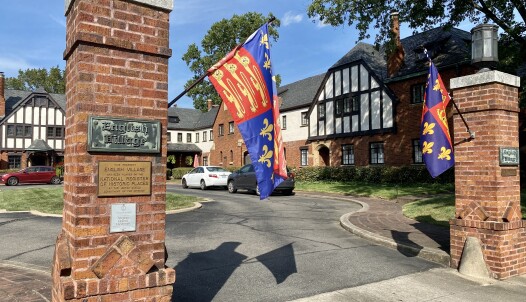A casual walk around the Fan or Museum District can transport you back a hundred years, when Anglophilia had taken hold and Richmond’s architectural community was abuzz with Tudor Revival design + the nostalgia associated with pre-industrial life.
Also known as “Mock Tudor,” this architectural style revisits the characteristics common before and during the Tudor period in England (1485-1603). Common features of the style include steeply pitched or cross-gabled roofs, decorative half-timbering, prominent chimneys, narrow windows with multiple panes, and patterned stone or brickwork.
While the Tudor Revival style appears to nod toward more rural aesthetics, it’s historically tied to elitist aristocracy and nobility. In fact, one of the most notable Tudor landmarks is Hampton Court Palace, conveniently located in our official sister city, Richmond upon Thames.
Now that you know a bit more about the architectural history — from pedigree English Tudor palaces to Richmond’s more rustic-inspired Revivals — where can you see Tudor Revivals around the city?
A castle on Monument Avenue

It’s all in the details at the Branch — from latticed windows to patterned brick chimneys. | Photo by @adam_n_goldsmith
Although the revival period took hold in Europe in the late 19th century, it didn’t gain momentum in Richmond until the construction of the Branch House.
Now home to the Branch Museum of Architecture and Design, the Branch House was originally designed by John Russell Pope and completed in 1919, making it one of the oldest examples of the Tudor and Jacobean Revival style in Virginia.
Shakespearean stomping grounds
Two Richmond manors — conveniently next-door neighbors — can trace their roots directly back to the Tudor era.
Agecroft Hall’s half-timbered structure dates back to the late 15th century, when it stood in Lancashire, England. Over four centuries later, it was deteriorating. A Richmond businessman and his wife bought the building at auction in 1925, dismantled it, and transported the pieces to their property overlooking the James River.

The Virginia House is a popular wedding venue nowadays. | Photo courtesy of Virginia Historical Society and Jennifer M. Guild, via Wikicommons
The Virginia House was built from the materials of a 16th-century English home called the Priory. Alexander and Virginia Weddell combined three Tudor designs when they moved the home across the Atlantic and constructed the west and east wings upon its arrival.
Time-traveling residency
Another example of the Tudor Revival is the English Village, a multi-family complex in the Museum District designed by local architect Bascom Rowlett. The planned townhome community was centered around a courtyard set back from the street.
A stock market stop
The Tudor Revival period largely declined around the late 1920s and early 1930s, when the stock market crash halted building projects around the city. However, the revival had already made a mark in Richmond — from lavish mansions to more modern approaches to middle-class living.
You can still spot Tudor Revivals, like ornate time capsules, around the River City today. Plus, now you’ll have a better idea of what to look for.














